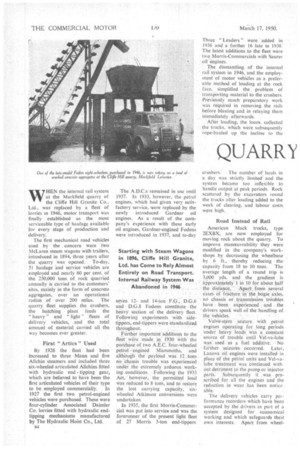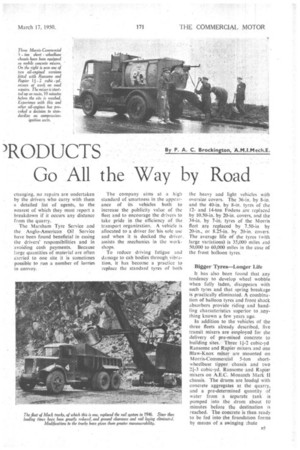QUARR)!
Page 38

Page 39

Page 40

If you've noticed an error in this article please click here to report it so we can fix it.
)RODUCTS By P. A. C. Brockington, A.M.I.Mech.E.
Go All the Way by Road
WHEN the internal rail system at the Markfield quarry of the Cliffe Hill Granite Co., Ltd., was replaced by a fleet of lorries in 1946, motor transport was finally established as the most serviceable type of haulage available for every stage of production and delivery.
The first mechanical road vehicles used by the concern were two Ise1cLaren steam wagons with trailers, introduced in 1894, three years after the quarry was opened. To-day, 51 haulage and service vehicles are employed and nearly 60 per cent. of the 250,000 tons of rock quarried annually is carried to the customers' sites, mainly in the form of concrete aggregates, over an operational radius of over 200 miles. The quarry fleet supplies the crushers, the hatching plant feeds the " heavy " and " light " fleets of delivery vehicles, and the total amount of material carried all the way becomes ever greater.
First " Artics " Used By 1926 the fleet had been increased to three Mann and five Allchin steamers and included three six-wheeled articulated Allchins fitted with hydraulic end tipping gear, which are believed to have been the first articulated vehicles of their type to be employed commercially. In 1927 the first two petrol-engined vehicles were purchased. These were four-cylinder Associated Daimler Co. lorries fitted with hydraulic endtipping mechanisms manufactured by The Hydraulic Hoist Co., Ltd.
54 The A.D.C.s remained in use until 1937. In 1933, however, the petrol engines, which had given very satisfactory service, were replaced by the newly introduced Gardner oil engines. As a result of the company's experience with these early oil engines, Gardner-engined Fodens were introduced in 1937, and to-day seven 12and 14-ton F.G., D.Q.6 and D.G.8 Fodens constitute the heavy' section of the delivery fleet. Following experiments with side tippers, end-tippers were standardized throughout.
Farther important additions to the fleet were made in 1930 with the purchase of two A.E.C. four-wheeled petrol erigined Mammoths, and althOugh the payload was 12. tons no 'chassis trouble was experienced under the extremely arduous working conditions. Following the 1933 Act, however, the permitted load was reduced to 8 tons, and to restore the lost carrying capacity, sixwheeled Atkinson conversions were undertaken.
In 1935, the first Morris-Commercial was put into service and was the forerunner of the present light fleet of 27 Morris 5-ton end-tippers Three " Leaders " were added in 1936 and a further 16 late in 1938 The latest additions to the fleet were two Morris-Commercials with Saurer oil engines.
The dismantling of the internal
• rail system in 1946, and the employment of motor vehicles as a preferable method of loading at the rock face, simplified the problem of transporting material to the crushers. Previously much preparatory work vas required in removing the rails before blasting and in relaying them immediately afterwards.
After loading, the locos. collected the trucks, which were subsequently rope-hauled up, the incline to the crushers. The number of hauls in a day was strictly limited and the system became too inflexible to handle output at peak periods. Rock scattered by the excavators round the trucks after loading added to the work of clearing, and labour costs were high.. .
Road Instead of Rail
American Mack trucks, type 2EXI3X, are now employed for moving rock about the quarry. To improve manceuvrability they were modified in the company's workshops by decreasing the wheelbase by 6 ft., thereby reducing the capacity from 18 to 10 tons. The average length of a round trip is 3,000 yds. and the gradient is approximately 1 in 10 for about half
the distance, Apart from several cases of fracture in the bogie axles, no chassis or ,transmission 'troubles have been experienced t and the drivers speak well of the handling of the vehicles.
Valve-stern seizure with ,petrol engines operating for Jong periods tinder heavy loads_ was a constant source of trouble until Vel-va-lube was used as a fuel additive. No further seizures occurred. Later, Lanova oil engines were installed in place of the petrol units and Vel-va,
lube treatment was continued without detriment to the pump or injector parts: Subsequently it was prescribed for all the engines and the areduction in wear has been notice bleThe delivery vehicles carry per
formance recorders which have been accepted by the drivers as part of a system designed for economical working and which safeguards their own interests. Apart from wheel cnanging, no repairs are undertaken by the drivers who carry with them a detailed list of agents, to the nearest of which they must report a breakdown if it occurs any distance from the quarry.
The Marsham Tyre Service and the Anglo-American Oil Service have been found beneficial in easing the drivers' responsibilities and in avoiding cash payments. Because large quantities of material are often carried to one site it is Sometimes possible to rim a number of lia?ries in convoy.
The company aims at a high standard of smartness in the appearance of its vehicles both to increase the publicity value of the fleet and to encourage the drivers to take pride in the efficiency of the transport organization. A vehicle is allocated to a driver forhis sole use and when it is docked the driver_ assists the mechanics in the workshops.
To reduce driving fatigue and damage to cab bodies through vibrafion, it has become a practice to replace the standard tyres of both
the heavy and light vehicles with oversize covers. The 36-in, by 8-id. and the 40-in. by 8-in. tyres of the 12and 14-ton Foderis are replaced by 10.50-in. by 20-in. covers, and the 34-in. by 7-in. tyres of the Morris fleet are replaced by 7.50-in by 20-in., or 8.25-in. by 20-in. covers The average life of the tyres (with large variations-) is 35,000 miles and 50,000 to 60,000 miles in the case of the front balloon tyres.
Bigger Tyres—Longer Life lt has also been found that any tendency to develop wheel wobble when fully laden, disappears with such tyres and that spring breakage is practically eliminated. A combination of balkoon tyres and front shock absorbers provide riding and handling characteristics superior to .anything known a few years. ago.
in addition to the Vehicles of the three fleets already described, five transit mixers are employed for the delivery of pre-mixed concrete to building sites. Three 11-2 etthic-yd Ransome and Rapier mixers and one Blaw-Knox mixer are mounted on Morris-Commercial 5-ton shortwheelbase tipper chassis and two 2i--3 cubic-yd. Ransome and Rapier mixers an A.E.C. Monarch Mark 11 chassis, The drums are loaded with concrete aggregates at the quarry, and a pre-determined quantity of water from a separate tank is pumped into the. drum about 10 minutes before the destination is reached. The concrete is then ready to be fed into the foundation forms by means of a swinging c.hute
Heavy machine parts up to 20 tons in weight have often to be trans'. ported from the plant installations to the workshops during maintenance periods. A 40-ton Rogers multiwheeled trailer is employed with a Foden tractor for this purpose. The Foden is fitted with a Westinghouse air system to operate the trailer brakes.
Other internal maintenance vehicles include a Morris-Commercial and a Fordson 5-ton truck, and a Taylor 2-ton Hydracrane mounted on a Morris-Commercial four-wheeldrive chassis. There are few lifting or transporting jobs which the Hydracrane has not been called upon to tackle and the machine is generally regarded as the maid-of-allwork on the site..
Oil-engined Humber
Two Jeeps are used for the transport of personnel, and recently the 27 h.p. petrol engine of a Humber brake was replaced by a P.4. Perkins engine to provide a large and economic passenger transport with an oil-fuel consumption rate exceeding 25 m.p.g.
Vehicle repair and service facilities are co-ordinated with plant maintenance for which a comparatively large staff is employed to meet peak periods. Consequently many transport jobs can be undertaken more expeditiously than is normally pos. sible with workshop facilities devoted to fleet maintenance.
A foreman and five mechanics in the fitters' and blacksmiths' shops maintain both the vehicle engines and the plant equipment. One man is constantly employed on wheel and tyre
maintenance. A painter, a signwriter, a fuel attendant and a carpenter also combine vehicle and plant work.
Full Range of Equipment
All body repairs, either in wood or in metal, are undertaken in the shops. The fitter's shop contains a valverefacing machine, an air-operated planishing machine (with 10 dollies) for panel beating, an Armstrong injector-testing machine, an electric bench drill, two Wolf pistol-grip drills, a Tecalemit greasing plant, two lathes, a planing machine, a power saw, and a slotter. Two static electric welders and one portable electric welder based on the blacksmiths' shop, enable any type of welding to be tackled and two expert operators are kept constantly employed rebuilding parts or undertaking modifications.
All the delivery vehicles are inspected once every 38 days, when they are docked for 24 hours. The inspection includes the usual maintenance checks and a thorough scrutiny or testing of such items as brake facings, universal joints, wheel bearings, steering pins, tipper gear and radiator mountings. A wide range of spares is kept in a central store.
The petrol engines are decarbonized at 35,000 vehicle-mile intervals, and new piston rings are generally fitted after about 65,000 miles. The average life of the engines corresponds to a vehicle mileage of approximately 80,000.
Foden vehicles cover about 65,000 miles before attention to the engine cylinder block is required. Normally two days are allowed for resleeving or a reblocking, this overhaul also including the fitting of a reconditioned head. At the same time, two of the five mechanics carry out necessary chassis work such as brake refacing and steering linkage renewals.
Oil Engines for Preference
The engines are replaced with factory reconditioned units at approximately 200,000-mile intervals, but during the war all major repairs were performed on the premises.
To date, the two oil-engined Morris Commercials have each covered about 35,000 miles and have confirmed good first impressions. Their performance and economy (fuel consumption rates average about 20 m.p.g.) have encouraged a decision, gradually to fit all petrolengined vehicles with oil engines as renewals fall due, and a big saving in costs is expected.




























































































